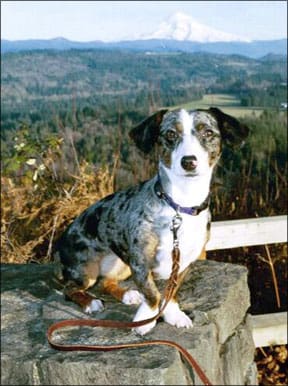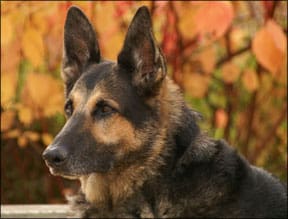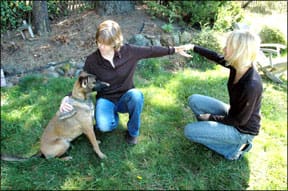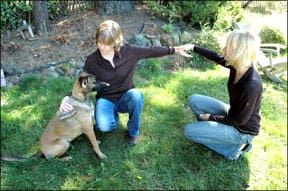Energy medicine, once so exotic that it was dismissed out of hand by America’s physicians and veterinarians, is now going mainstream. In addition to the therapies described last month (see “Alternative Views on Holistic Dog Care,” Whole Dog Journal October 2007), energy healing techniques such as flower essences, animal communication, and kinesiology are used by holistic veterinarians in the U.S. and around the world. Understanding what these therapies are and how they work will help you decide which energy therapies might be appropriate for your canine companion.

288
Flower essences
There’s nothing unusual about a dog responding to an herbal tea or capsule. Plants have been used for thousands of years to treat all kinds of conditions.
But flower essences, which are also called flower remedies, are very different from herbal products. Like homeopathic remedies, they contain little or none of the material used to produce them. Instead, they store a plant’s “vibration” or “imprint,” which in turn affects the animal’s energy. These vibrations or imprints are said to act directly on the animal’s emotions.
Conventional veterinary medicine finds no credible explanation for either homeopathy or flower essences, but physicists and other energy researchers say that on the atomic level, tiny amounts of matter contain subtle but powerful forces. For those interested in energy research, medical journalist Lynne McTaggart’s book, The Field: The Quest for the Secret Force of the Universe, reviews hundreds of scientific and medical reports that explore this subject.
Flower essences were developed by Edward Bach, an English physician and homeopath, in the early years of the 20th century. Dr. Bach filled small glass bowls with pure spring water, placed freshly picked blossoms on the water’s surface, and left the bowls in direct sunlight for three hours. During this time, he theorized, the water became impregnated with the plants’ healing powers.
He then discarded the blossoms and preserved the activated water in brandy. As in homeopathy, this basic formula was called the “mother tincture.” When diluted with additional brandy, the result was called the “stock” remedy.
By far the most famous flower remedy blend is Dr. Bach’s formula for emergency and stress, which is sold under the brand names (depending on the manufacturer) Rescue Remedy, Calming Essence, Five Flower Formula, and Trauma Remedy in health food stores, pharmacies, pet supply stores, and online. It contains star of Bethlehem for shock, rock rose for fear and panic, impatiens for tension and mental agitation, cherry plum for lack of emotional control, and clematis for the sensation one experiences just before fainting.
According to Helen Graham and Gregory Vlamis in their book Bach Flower Remedies for Animals, Rescue Remedy and similar emergency remedies can be used:
• As an adjunct to any treatment for illness, surgery, injury, trauma, or shock
• As a safe alternative to tranquilizers and sedatives
• To help revive weak newborn puppies
• To combat the aftereffects of anesthesia and to revive puppies delivered by caesarean section
• To help resuscitate dogs whose breathing has stopped or help dogs who are having trouble breathing
• After any seizure or convulsion
• To speed recovery from heatstroke or exhaustion
• To speed the healing of wounds
• To help dogs relax at the groomer’s salon, veterinary clinic, obedience school, dog park, or any stressful surroundings
• To support dogs living in shelters
• To improve mental focus and learning
Like all flower essences, Rescue Remedy can be applied directly from the stock bottle, a drop or two at a time. The remedy can be dropped into the dog’s mouth, massaged into the gums, applied to the nose or paw pads, or applied to bare skin on the abdomen or ears.
Canine massage therapists often incorporate flower essences in their hands-on work, as do practitioners of canine acupressure. Applying flower essences to a chakra or an acupressure point and then pressing, holding, massaging, or tapping the point can increase the treatment’s effectiveness – especially if the flower essence addresses an emotional issue affecting the dog.
Flower essences at work
Every blossom used in flower essences has a unique significance. The bewildering assortment of remedies and their unusual application methods make the study of flower essences confusing at first. But there are many resources and guides to help the novice.

288
“The most reassuring thing about these products,” says flower essence practitioner and manufacturer Christina Blume of Denver, Colorado, “is that they are totally safe. You cannot overdose on flower essences. If you use an inappropriate remedy, nothing happens. There are no adverse side effects.”
And if you use the right remedies, the results can be amazing.
One of Blume’s neighbors, who is not a dog person, got a guard dog for protection. She called Blume in a panic when the dog tangled with a porcupine and his face was covered with quills. “As soon as I saw him,” says Blume, “I ran home and mixed trauma and fear remedies with water in a spray bottle.”
Blume stood on one side of the gate while the dog, who didn’t know her, slavered, growled, and barked. “I sprayed and sprayed and sprayed him,” she says. “Within about two minutes, he let me come through the gate, load him into the car, and take him to the vet. He even stayed calm at the vet clinic.”
Many dog lovers discover flower essences during the summer. “Fourth of July fireworks and summer thunderstorms send people scrambling for anything that might help their frightened dogs,” she says. “Fear is also the underlying cause of separation anxiety. I have received more e-mail messages, letters, and phone calls about dogs who have overcome their fears with the help of flower essences than any other topic.”
Consider Kaniq, an American Eskimo Dog living with Carol Allen in Denver. “I am blessed to be able to take him to work every day. My co-workers all adore him, and as a result he is very spoiled,” says Allen. “But all this attention during the week leaves him with a major case of separation anxiety when my husband and I leave him home alone when we run errands or go out for dinner on the weekend.”
For the first 18 months of Kaniq’s life, the Allens came home to chewed clothes, papers, books, and shreds of whatever else their dog could reach. “He would even pull things down off the wall and destroy them,” she says. “It didn’t matter if we were gone for 15 minutes or two hours, he got into everything and drove our family crazy. And, of course, he was just as miserable as we were.”
After several unsuccessful attempts to solve the problem, the Allens met Christina Blume, and tried one of her flower essence products that she calls “Loneliness Blend.”
“To be perfectly honest,” says Allen, “my husband and I were quite skeptical that anything like a flower remedy would work any better than the hundreds of hours we had put into training. But it came free with a class we attended, so we tried it.”
At the end of day one on the Loneliness blend, Kaniq had not destroyed anything. “Holy cow,” says Allen. “That was exciting! Then we thought it had to be a coincidence. We just didn’t leave anything where Kaniq could reach it. Right?”
On day two, they tested him. “We gave him his dose and left him for half an hour with a cardboard box. We expected to find the box torn up. Nope. Totally wrong. We returned to find a happy dog greeting us at the door, pleased to have us home.”
Now when they leave to go out to dinner or attend other events in the evenings or on weekends, they get Kaniq’s blend out. “He sees it and comes running,” says Allen. “As long as we give it to him, we return to a happy dog and a happy house. I would definitely recommend flower remedies to anyone whose dog suffers from fear, anxiety, or any other harmful emotions.”
Loneliness remedy has worked well for many re-homed dogs, including Beagles placed by a local Beagle rescue group. “Like Kaniq,” says Blume, “these dogs would panic and wreck the house. Some tore sofas apart. But they responded really well to the Loneliness remedy. Its key ingredient is prickly pear cactus, which blooms here in Colorado. Its vibration seems to work especially well for all of the issues that can result from being alone.”
In addition to making and distributing individual essences and her Loneliness and Trauma remedies, Blume creates blends such as Confidence, for overly sensitive dogs or to help dogs feel courageous; Focus and Concentration, for distracted dogs; Competition, for increased courage and strength; Transportation Ease, for traveling dogs; and Antzy Pantz, for hyperactive dogs or dogs with a lot of nervous energy. Instead of alcohol, she uses a vegetable glycerine base, which has a sweet taste that dogs enjoy.
“For all flower essence applications,” says Blume, “I recommend putting 12 drops in a 4-ounce atomizer bottle filled with distilled water. You can spray the essence in the air and on the dog’s bedding, and brush or rub it into the dog’s coat. I also apply the essence to the dog’s chakra points and massage it between her eyes and on her gums, put it on her paw pads, on the inside of her ears, and on her nose. While the dog is licking the essence off her nose and toes, I apply it to her abdomen and give her a tummy rub. I also put the essences on treats and dog biscuits and add it to her broth or food.”
The key to success with flower essences, she says, is frequency of application.
“When I’m serious about getting good results,” she says, “I’ll apply diluted or full-strength remedies as often as possible. I suggest to clients that they apply the essences first thing in the morning, just before they leave for work, as soon as they get home, and again just before bed. But if you can apply them more often, such as every hour, that works even better.”
Blume adds four drops of a flower essence to dogs’ water bowls, including communal bowls. “The wonderful thing about flower essences,” she says, “is that if a dog drinks a remedy that he doesn’t need, it doesn’t hurt him. I don’t worry, in multiple-pet households, about separating animals and remedies. The animal who needs the remedy will respond and the others are never harmed.”
To help newcomers use flower essences, organizations like the Flower Essence Society in the U.S. and the Bach Centre in England provide books, training guides, online resources, workshops, and other assistance. A growing number of flower essence practitioners specialize in animal care, and the American Holistic Veterinary Medical Association directory lists 300 veterinarians who treat animals with flower essences.
In recent years, remedies made from materials other than plants have become popular. For example, “gem elixirs” are infused with the energy of semiprecious and precious stones. Essences are also made from water, ice, or sunlight collected at sacred sites. These experimental remedies have not yet been systematically tested by thousands of practitioners the way most flower remedies have, but in time they may be shown to affect the emotions in much the way flower essences do.
Animal communication
Can you talk to animals? Of course you can – but do they understand you? And if they answer, do you understand them?

288
Many have observed that humans are reasonably good senders of information, and dogs are good receivers. But while dogs are also good senders, we humans are all too often poor receivers, obtaining static, blurred images, tangled hunches, or nothing at all. That’s why so many of us look askance at people who claim to know what animals are thinking – and why we’re amazed when their reports from animals are specific, detailed, and on target.
Jessica Westleigh works with animals in person and from a distance using a variety of energy healing modalities. Her background involves dogs, horses, and other animals. She worked as an Animal Veterinary Technician at Tufts University in Massachusetts, as a registered instructor for the North American Riding for the Handicapped Association, and as a professional dressage instructor and trainer. A breeder of champion Australian Shepherds, she now lives near a rain forest in Puerto Rico.
In her energy treatments, Westleigh works with an animal’s aura (the subtle multicolored luminous radiation or electromagentic field that surrounds all living creatures) and chakras (the seven energy centers discovered in ancient India and used in many healing techniques) using methods such as channeling, streaming, Reiki, and consulting a pendulum to receive information, unlock chakras, and re-energize the animal’s system.
“What’s given me a great insight into the different healing modalities,” she says, “is that by communicating with the animal while I’m doing everything else, I can use or recommend the herbs, flower essences, and long-distance energy or Reiki healing that will work best for the patient. I work with animals to get their exact symptoms so that I know how to treat them.”
Westleigh speaks with her animal clients and interprets their images, thoughts, and emotions for general information. She then performs what’s called a body scan. “That’s where I pick up on physical issues,” she says. “When I receive this information, I might feel a temperature change or a sensation of numbness or tingling or even physical pain. In many cases I get words from the animal, and some dogs give me specific and detailed descriptions of what’s going on in their lives. All of this helps me determine what form of energy healing will be most beneficial.”

288
Westleigh relies on the phone and e-mail to schedule appointments, but she does all of her animal work in a meditative state in the rain forest or on the beach. “I receive everything directly at that time,” she says. “The patient can be hundreds or thousands of miles away and engaged in normal everyday activities. The animal doesn’t have to be in any particular place or doing anything special.”
She usually works with new canine clients in daily 90-minute sessions for one week, at the end of which she and the owner or caregiver assess the dog’s progress.
Puka is a five-year-old Corgi mix from the island of Kauai in Hawaii who now lives in Boring, Oregon, with Kathleen Kane. Raised in a feral pack that was used for boar hunting, Puka was five months old when she was taken to a shelter. That’s where she met Kane, who was in Hawaii on vacation.
“Puka has had both physical and emotional problems,” says Westleigh, “everything from urinary incontinence issues to severe separation anxiety, and she has a hitch in one of her hind legs, where she skips a beat every few strides.
“I started by doing long-distance Reiki and EFT (Emotional Freedom Technique, another form of energy medicine), and by the end of that first week, Kathleen reported significant changes in Puka’s character and personality. She suddenly became much more outgoing and confident. Kathleen could leave her and she didn’t experience her usual panic and separation anxiety. But what surprised her most was Puka’s physical improvement. A lot of the heat that had been in her back was gone, she stopped urinating in her sleep, and she just became a happier dog.”
Another long-distance client is Nitro, a 14-year-old German Shepherd Dog belonging to Roseanne Carbone in St. Paul, Minnesota. Nitro has degenerative myelopathy, or DM, a neurologic disease that affects the spinal cord and eventually results in paralysis.
“I’ve been working with Nitro for a year and a half,” says Westleigh, “and Roseanne credits the combination of energy work he’s been receiving and the care of Dr. Deb Brown, his holistic veterinarian in Pequot Lakes, Minnesota, for keeping him alive. I work with him every other Friday. Roseanne says that when she leaves for work, he’ll be uninterested in breakfast and dragging his hind end, but when she comes home after our session, he’s standing at the front door, tail wagging, with a toy in his mouth, and his appetite is back.”
Dr. Brown treats Nitro with acupuncture and herbs. “I get information, sensations, and symptoms directly from Nitro,” says Westleigh, “and at Nitro’s next veterinary appointment, which is usually a day or two later, Roseanne passes this information on to Dr. Brown, who incorporates it into her treatments. I open up his chakras and his meridians to help get his body ready for the work that she’s going to do.”
Westleigh often works with or is referred by holistic veterinarians and other healthcare providers who make up a team that exchanges information. “Usually it’s the owner who coordinates this,” she says. “There might be a kinesiologist in the picture who is able to verify my observations with muscle testing. Then a veterinary homeopath or other practitioner prescribes specific treatments. Energy work, flower essences, homeopathy, chiropractic adjustments, acupuncture, acupressure, massage therapy, nutrition, and other holistic therapies all work very well together.”
Can anyone learn how to communicate with animals, or do you have to be born with the skill?
Many animal communicators, such as Penelope Smith in Prescott, Arizona, say we can all learn how to exchange ideas with our animal companions. Smith, who has written several best-selling books about animal communication, edits a quarterly journal, Species Link, and provides training programs and DVDs.

288
In fact, many adult schools and training centers offer classes and workshops. If you’d rather work with an expert, your holistic veterinarian, groomer, trainer, or dog club may be able to refer you to an animal communicator. Check local metaphysical magazines and newsletters as well.
Do you know what your dog really thinks? “You probably don’t,” says Jessica Westleigh, “but I can promise you this. Your dog has important things to tell you, and she probably wishes you could read her mind!”
Kinesiology
Now that you know your dog can talk to you, did you know that your body can talk to you, too? Not only that, but your body knows things that your conscious mind knows nothing about.
That’s what George Goodheart, DC, discovered in the early 1960s, when he found that muscles could be tested in ways that revealed information about the rest of the body. Dr. Goodheart called his discovery Applied Kinesiology.
When the person performing the test asks questions and checks the strength or weakness of indicator muscles, the individual being tested unconsciously communicates internal information.
Healthcare practitioners use muscle testing to determine what specific imbalances or chemical sensitivities exist in the body; the health status of different organs, acupuncture points, and meridians; and the best specific treatments for enhancing health.
To test whether an indicator muscle is strong or weak, the tester usually presses down on the hand or arm of the person being tested, while that person resists by holding the arm straight. The body’s muscles are strengthened by statements with which it agrees and weakened by statements with which it does not agree. You can be convinced that dark chocolate is your personal health food, but if holding, looking at, or thinking about a chocolate bar leaves you weak all over, a tester’s light pressure will send your arm to the floor.
Factors that can impede accurate muscle testing include dehydration, unwanted distractions, loud noises, and electromagnetic interference. In ideal conditions, all parties have had plenty of water, the room is quiet, and there are no environmental problems.
For those too young, incapacitated, or infirm to test, or for testing animals, surrogate testing works just as well. In surrogate testing, an intermediary person touches the person or animal being tested with one hand and resists the tester’s gentle pressure with the other. Today in many veterinary clinics, staff members are experienced surrogate testers.
Wendy Volhard, co-author of the best-selling Holistic Guide for a Healthy Dog, has introduced kinesiology to thousands. In the early 1980s, when she planned to add muscle testing to the nutrition and health curriculum at her training camps, Volhard’s staff warned her not to even mention the subject. “It’s quackery!” they exclaimed.
“But I had so much success with it that I felt driven to teach it,” she says. “If you can accept Einstein’s theory that all matter has energy, sooner or later you will believe in kinesiology, too.”
Volhard devotes a chapter of her book to kinesiology and gives detailed instructions. To test your dog, she explains, have her lying on your left while you sit on the floor next to her. Remove the dog’s collar if it contains metal. If it isn’t already in a closed container, place whatever you plan to test (a small amount of dog food, a treat, a flower essence, medication, etc.) in a plastic bag or glass jar. Hold it in contact with the dog’s body anywhere except the head area.
Extend your right arm parallel to the ground. Have your tester push down on your wrist. “You will immediately know the result,” she says. “A strong response means the item being tested is okay for your dog. A weak response means it is not the best choice. If you get a weak response, test several items, such as several different foods or treats, until you find one that tests strong. All individuals have their own body chemistry, so results are bound to vary.”
Another way to do surrogate testing is to test yourself without needing another person’s help. Kinesiologists have discovered many methods for obtaining clear “yes” or “no” answers (see a list of online descriptions in the resources, below). Christina Blume uses a pendulum to determine which remedies a particular dog’s needs by going down her printed list of flower essences, pointing to each one, and noting the answers.
“Whatever method you use,” she says, “whether it’s holding a pendulum and waiting for it to move clockwise or counterclockwise, or forward and back or sideways, or whether you use one of the many finger, hand, or body muscle self-tests, the keys are practice and experience. It took only a few days to discover my personal ‘yes’ and ‘no’ indicators, but it took three months for me to trust the results. The energetics of intention are powerful. Trust that your desire to aid your beloved dog is coming through in your search for answers.”
Thanks to trainer Sarah Richardson, of Chico, California, for demonstrating the techniques in this article.






